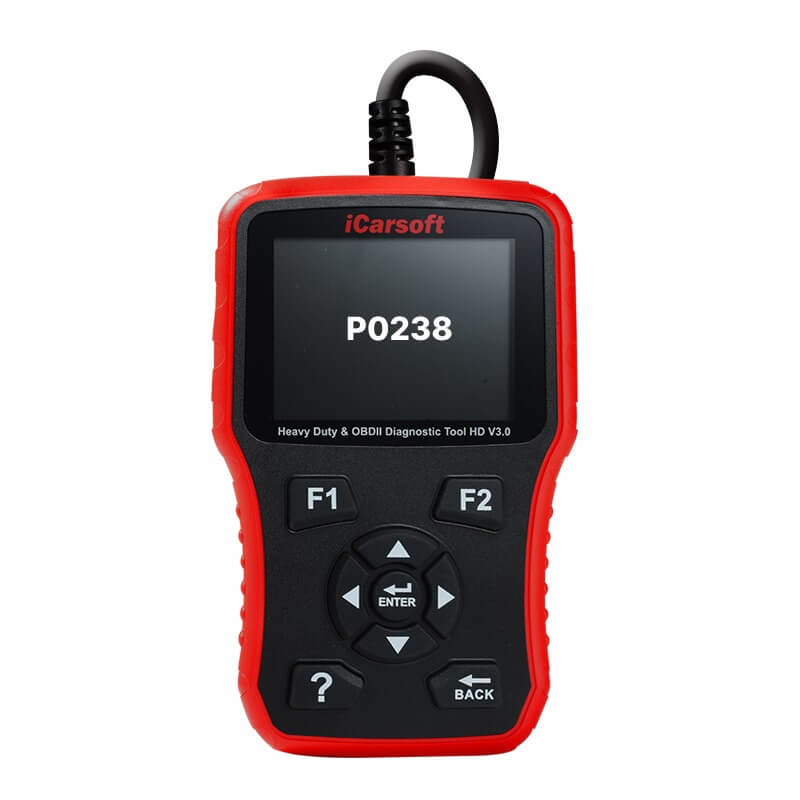P0238 – Turbocharger Boost Sensor A Circuit High
POSTED IN pcodes
Welcome to our article on P0238 – Turbocharger Boost Sensor A Circuit High. In this section, we will provide you with a technical description, meaning, severity, symptoms, common causes, troubleshooting steps, and repair options related to this diagnostic trouble code (DTC).
Key Takeaways:
- P0238 is a diagnostic trouble code indicating a high input voltage in the turbocharger boost sensor A circuit.
- Common symptoms include an illuminated Check Engine Light and a lack of power during acceleration.
- Possible causes include a shorted boost sensor, a damaged connector, or a short circuit in the wiring.
- To diagnose the P0238 code, a mechanic will typically scan for codes, check the boost pressure sensor signal, and inspect the wiring and connector for any damage or corrosion.
- Repairs for the P0238 code may involve replacing the boost sensor, repairing the wiring or connector, or even replacing the ECM if necessary.
Symptoms of P0238 – Turbocharger Boost Sensor A Circuit High
When encountering the P0238 code, it is essential to be aware of the symptoms that may indicate its presence. These symptoms can help identify the issue and guide the diagnosis process.
- An illuminated Check Engine Light (CEL): One of the most common symptoms is the appearance of the Check Engine Light on your vehicle’s dashboard. This warning light serves as an indicator that something is amiss with your turbocharger boost sensor.
- Lack of power or reduced engine performance: Another noticeable symptom is a decrease in engine power, particularly during acceleration. You may experience a lack of power when trying to accelerate or climb hills. This loss of power can be frustrating and significantly impact your driving experience.
It is important to pay attention to any additional symptoms or issues that may be present, as they can provide valuable clues during the diagnosis and repair process.
Causes of P0238 – Turbocharger Boost Sensor A Circuit High
The P0238 code can be caused by several factors related to the boost sensor, connector, and wiring. It is crucial to inspect these components for any signs of damage or corrosion.
Faulty Boost Sensor
A faulty boost sensor may be internally open circuit, causing an inaccurate signal to be sent to the Engine Control Module (ECM). This can result in the ECM detecting a high voltage reading and triggering the P0238 code.
Buy tested tuning file for Adblue / EGR / DPF / Adblue off now!
Damage to Connector
A damaged connector can lead to an open circuit or poor connection between the boost sensor and the ECM. This can disrupt the signal transmission, causing the ECM to interpret it as a high voltage condition and generating the P0238 code.
Short Circuit in the Wiring
A short circuit in the wiring can cause the boost sensor signal to be shorted to power. This results in a continuous high voltage reading, prompting the ECM to activate the P0238 code.
To accurately determine the cause of the P0238 code, a thorough inspection of the boost sensor, connector, and wiring is essential. Any signs of damage or corrosion should be addressed promptly to prevent further complications.
| Cause | Explanation |
|---|---|
| Faulty Boost Sensor | Internal open circuit in the boost sensor leads to an inaccurate signal. |
| Damage to Connector | Open circuit or poor connection between boost sensor and ECM. |
| Short Circuit in Wiring | Boost sensor signal shorted to power, resulting in high voltage reading. |

Diagnosing and Repairing P0238 – Turbocharger Boost Sensor A Circuit High
Diagnosing and repairing the P0238 code in your vehicle’s turbocharger boost sensor A circuit is a crucial step to restore optimal performance. To successfully diagnose the issue and make the necessary repairs, follow these steps:
1. Scan and Document Codes
Begin by scanning the vehicle’s codes using an OBD-II scanner. Document the freeze frame data to verify the P0238 code and understand the specific conditions that triggered it.
2. Clear Codes and Perform Tests
Clear the codes and observe if the concern returns. This step helps determine if it is an intermittent issue or a persistent problem. Perform further tests to pinpoint the exact cause of the code.
3. Check Boost Pressure Sensor Signal
One crucial test is checking the operation of the boost pressure sensor signal. Compare the readings from the boost sensor to the readings from the manifold absolute pressure (MAP) sensor at engine idle. Any significant variations should be noted.
4. Inspect Wiring and Connector
Inspect the wiring harness and connector for the boost sensor. Look for signs of shorts to power or corrosion. Any damaged wiring or poor connections can contribute to the P0238 code.
5. Compare Readings to Specifications
Compare the readings from the boost sensor to the specifications outlined in the sensor data scan. This step will help determine if the sensor is operating within the recommended range or if it needs replacement.
6. Make Necessary Repairs
Once the cause of the P0238 code is determined, proceed with the necessary repairs. This may involve replacing the boost sensor, repairing the wiring or connector, or even replacing the Engine Control Module (ECM) if it is found to be faulty.
By following these diagnostic and repair procedures, you can effectively address the P0238 code and ensure your vehicle’s turbocharger boost sensor A circuit is functioning optimally.

Diagnosing and Repairing P0238 – Turbocharger Boost Sensor A Circuit High
| Steps | Description |
|---|---|
| 1 | Scan and document codes |
| 2 | Clear codes and perform tests |
| 3 | Check boost pressure sensor signal |
| 4 | Inspect wiring and connector |
| 5 | Compare readings to specifications |
| 6 | Make necessary repairs |
Preventing and Addressing P0238 – Turbocharger Boost Sensor A Circuit High
To prevent misdiagnosis of the P0238 code, it is important to follow guidelines and perform thorough tests and inspections. Take the necessary precautions to address this issue and ensure the proper functioning of your vehicle.
One common mistake is failing to disconnect the boost sensor to see if the short to power and code goes away or changes. This step can help pinpoint the root cause of the issue and avoid unnecessary repairs.
It is also crucial to check the harness for any melting from loose or hanging wire looms on the exhaust. A short circuit caused by damaged wiring can trigger the P0238 code. By identifying and rectifying any wiring issues, you can prevent further complications.
The P0238 code should be addressed as soon as possible to prevent further damage to the engine or other critical components of your vehicle. Ignoring this issue can lead to a burned out ECM, causing your engine to stall and fail to start.
By addressing the P0238 code promptly and making the necessary repairs, you can prevent further issues and restore your vehicle to optimal performance. Ensure the longevity and reliability of your turbocharger system by taking preventive measures and acting swiftly to resolve any detected problems.
Key Points:
- Disconnect the boost sensor to identify any changes in the short to power and code.
- Inspect the harness for any signs of melting from loose or hanging wire looms on the exhaust.
- Address the P0238 code promptly to prevent a burned out ECM, stalling, and failure to start.
- Make the necessary repairs to restore optimal performance and prevent further issues.
Conclusion
Addressing the P0238 code, which indicates a high input voltage in the turbocharger boost sensor A circuit, is crucial for maintaining the optimal performance of your vehicle. Through proper diagnosis and repair, you can identify and resolve the underlying cause of the code, preventing further damage or issues.
It is important to follow the recommended diagnostic and repair procedures outlined by a qualified mechanic or professional service to ensure accurate and efficient resolution. By doing so, you can effectively address the P0238 code and restore your vehicle’s turbocharger system to its full functionality, eliminating any limitations on power and acceleration.
Additionally, taking preventative measures can help you avoid future occurrences of the P0238 code. Regular inspection of the wiring harness for any signs of damage or wear, as well as addressing any issues promptly, can significantly reduce the risk of encountering this code in the future.
Remember, by addressing the P0238 code promptly and making the necessary repairs, you can maintain the longevity and performance of your vehicle. Not only will you prevent further damage to the engine and other components, but you will also clear the Check Engine Light, ensuring peace of mind on the road.
FAQ
What does the P0238 code mean?
The P0238 code indicates a high input voltage in the turbocharger boost sensor A circuit.
What are the symptoms of the P0238 code?
Common symptoms of the P0238 code include an illuminated Check Engine Light and a lack of power during acceleration.
What are the common causes of the P0238 code?
Possible causes of the P0238 code include a shorted boost sensor, a damaged connector, or a short circuit in the wiring.
How is the P0238 code diagnosed and repaired?
To diagnose the P0238 code, a mechanic will typically scan for codes, clear the codes to see if they return, check the boost pressure sensor signal, inspect the wiring and connector for any damage or corrosion, and compare readings to specifications. Repairs may involve replacing the boost sensor, repairing the wiring or connector, or even replacing the ECM if it is internally shorted.
How can I prevent and address the P0238 code?
Preventive measures, such as inspecting the wiring harness for damage and addressing any issues promptly, can help avoid the P0238 code. By addressing the code promptly and making the necessary repairs, further issues can be prevented and the vehicle can be restored to optimal performance.
What is the importance of addressing the P0238 code?
It is important to address the P0238 code as soon as possible to prevent further damage to the engine or other components. A short to a power source in the sensor circuit can cause the ECM to get internally burned out, resulting in a stall and a failure to start.


